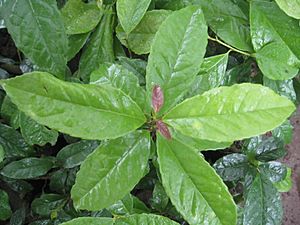Ilex guayusa facts for kids
Quick facts for kids Ilex guayusa |
|
|---|---|
 |
|
| Scientific classification | |
| Genus: |
Ilex
|
| Species: |
guayusa
|
Ilex guayusa is a type of tree that belongs to the holly family. It grows naturally in the Amazon rainforest. Guayusa is special because its leaves contain caffeine, just like coffee or tea. People pick the fresh leaves and brew them to make a drink that helps them feel more awake and focused.
Contents
What Guayusa Looks Like
Guayusa is an evergreen tree, meaning it keeps its leaves all year round. It can grow quite tall, from about 6 to 30 meters (20 to 100 feet).
- Leaves: The leaves are shaped like an oval or a spear. They are usually 7 to 22 centimeters (3 to 9 inches) long and 2.5 to 7 centimeters (1 to 3 inches) wide. Their edges are often slightly jagged.
- Flowers: The flowers are small and white, growing in clusters.
- Fruit: The fruit is round and red, about 6 to 7 millimeters (a quarter of an inch) across.
Guayusa trees are also dioecious. This means that male and female flowers grow on separate trees.
Where Guayusa Grows
Ilex guayusa is originally from the upper Amazon regions. You can find it in countries like Ecuador, Peru, and southern Colombia. It usually grows in areas between 200 and 2,000 meters (650 to 6,500 feet) above sea level. It has also been found in Bolivia.
This tree prefers forests that are always green or those that lose their leaves sometimes, especially in mountain areas. Even though it grows in the wild, most Guayusa trees are grown by people, especially in the Ecuadorian provinces of Napo and Pastaza.
How Guayusa Grows and Lives
Guayusa grows best in sandy-loamy soils that are a bit acidic. It likes the warm, wet conditions of the lowland and mountain jungles in South America.
Even though Guayusa trees have both male and female parts (or sometimes both types of flowers on one tree), they don't often produce many fertile seeds. Because of this, they mostly reproduce in other ways. They can grow new plants from shoots that sprout from the base of the tree or from underground stems.
When it's young, Guayusa grows under the shade of bigger trees. As it gets more light, it spreads its branches and eventually grows into a tall tree.
History of Guayusa Use
People have been using Guayusa for a very long time. The oldest proof of its use is a bundle of Guayusa leaves found in a 1,500-year-old tomb in the Bolivian Andes. This was far from where the plant naturally grows, showing that people moved it around.
In 1683, a priest named Juan Lorenzo Lucero wrote about the Jivaroan peoples drinking Guayusa infusions every day. During the 1700s, missionaries in Colombia, Ecuador, and Peru also wrote about the plant. They noted its use for digestion and its ability to make people feel more energetic.
The Jesuits, a religious group, knew about Guayusa's uses and actively traded it. In 1857, a scientist named Richard Spruce found a group of Guayusa trees near Baños, Ecuador. People believed these trees had been grown there since before Christopher Columbus arrived in the Americas.
Names for Guayusa
Guayusa has different names depending on the local language:
- Spanish: guayusa
- Kichwa: waisa
- Shuar: wayus, wais
How People Use Guayusa
The leaves of Ilex guayusa are used to make a popular drink, especially in Ecuador, Peru, and Colombia. After the leaves are picked, they are dried. This drying process helps the flavor develop.
Some Jivaroan peoples in Ecuador and Peru have a special tradition. They drink large amounts of Guayusa before dawn during ceremonies. This is done to cleanse their bodies and avoid taking in too much caffeine. The Quechua people also use Guayusa in a ritual. They drink it to have dreams that might help them find success on hunting trips.
Guayusa is also a social drink. The Kichwa people in Ecuador often drink it at parties and local festivals. In Ecuador, Peru, and Colombia, Guayusa is also used to make homemade alcoholic drinks.
What's Inside Guayusa
Guayusa leaves contain several interesting chemicals. The most well-known is caffeine, which makes up about 1.73% to 3.48% of the leaves. They also contain theobromine and other similar compounds like paraxanthine and theophylline. These are all stimulants.
Besides stimulants, Guayusa leaves also have:
- L-theanine
- gallic acid
- guanidine
- isobutyric acid
- nicotinic acid (also known as Vitamin B3)
- ascorbic acid (Vitamin C)
- riboflavin (Vitamin B2)
- choline
- pyridoxine (Vitamin B6)
- triterpenes
- chlorogenic acid
- Sugars
These compounds contribute to the plant's effects and its nutritional value.
Images for kids
See also
 In Spanish: Ilex guayusa para niños
In Spanish: Ilex guayusa para niños




